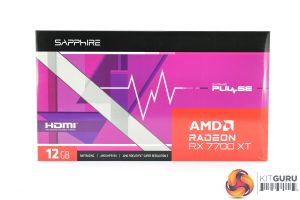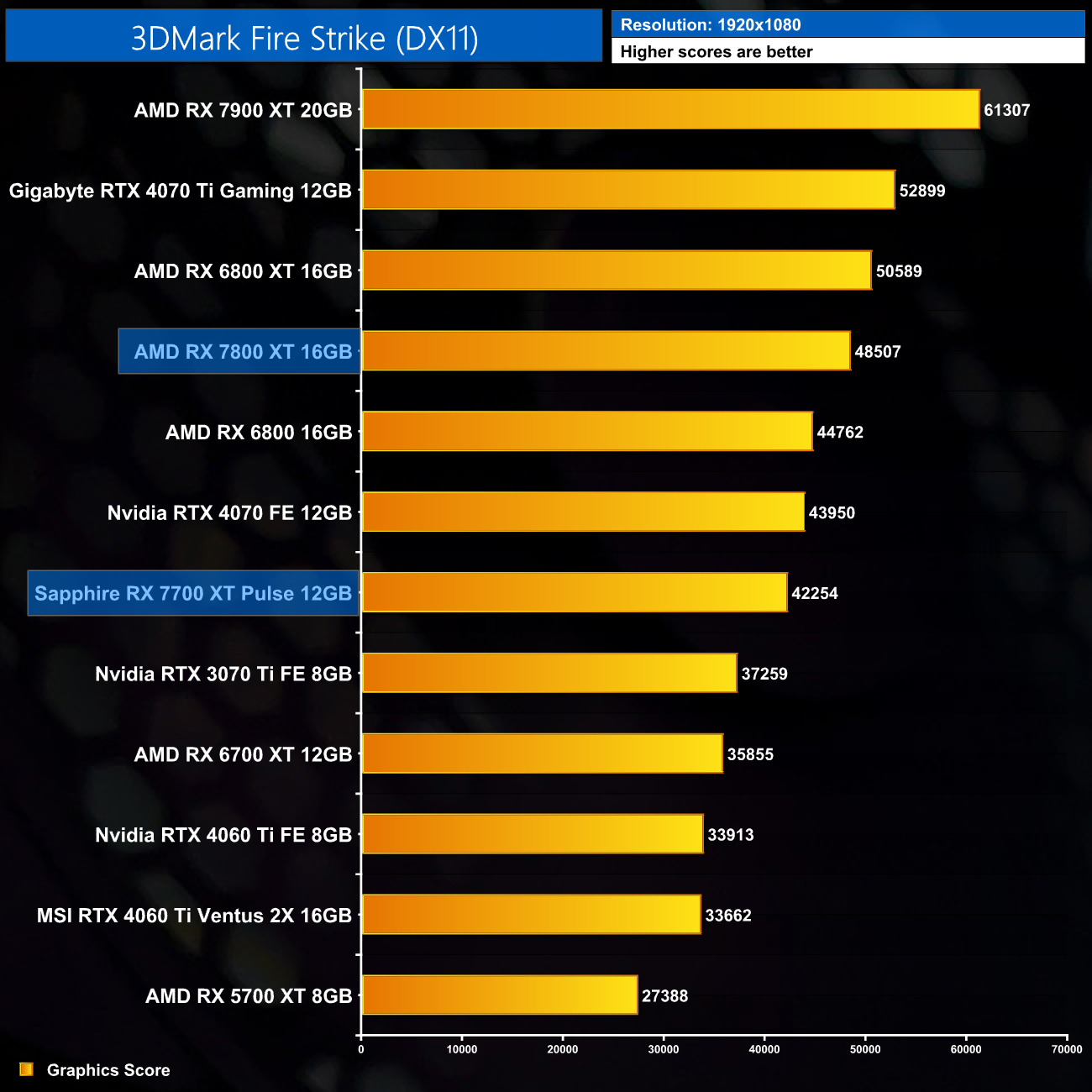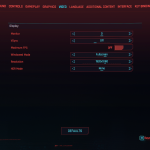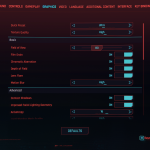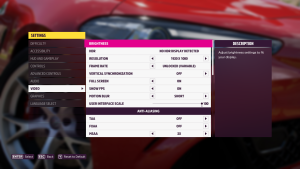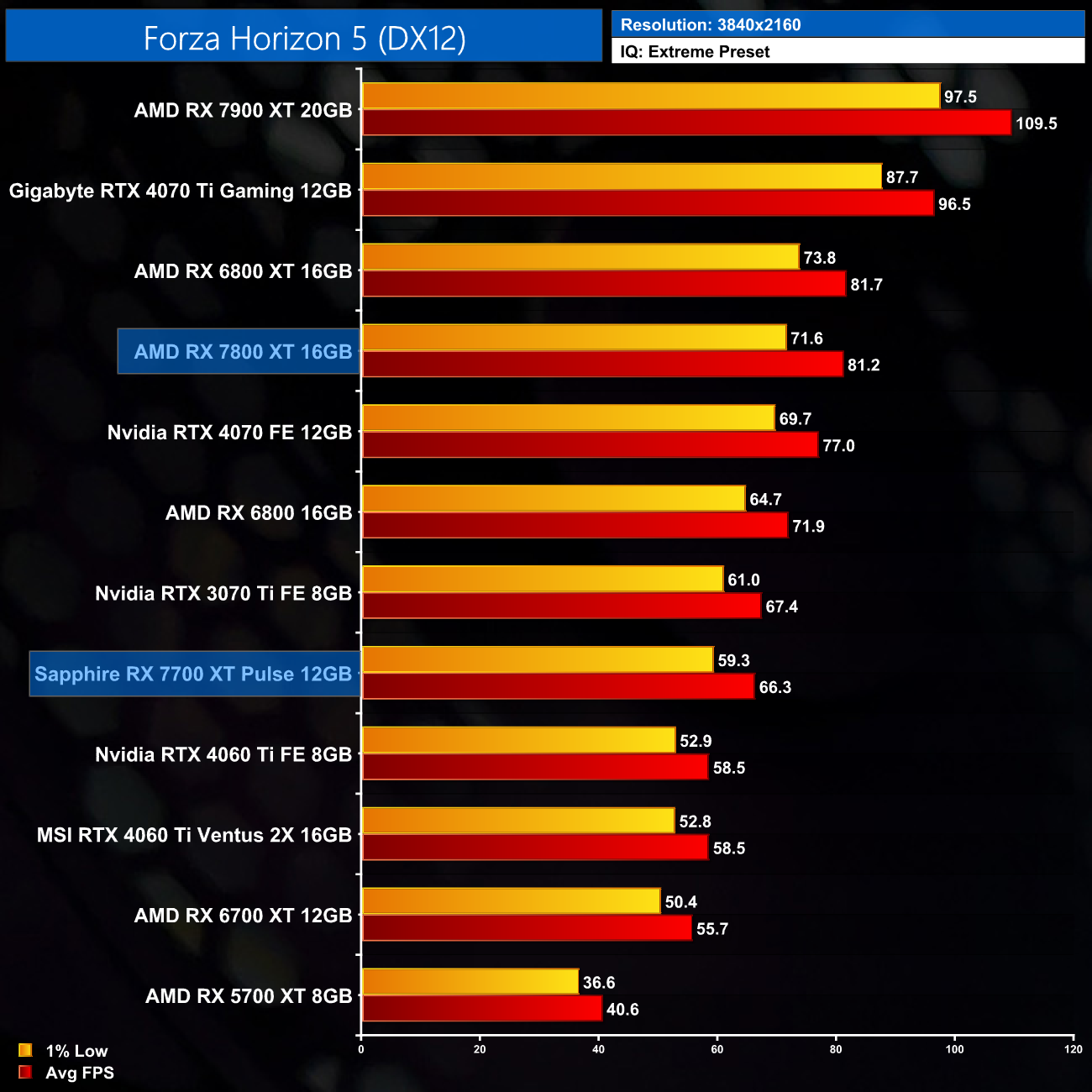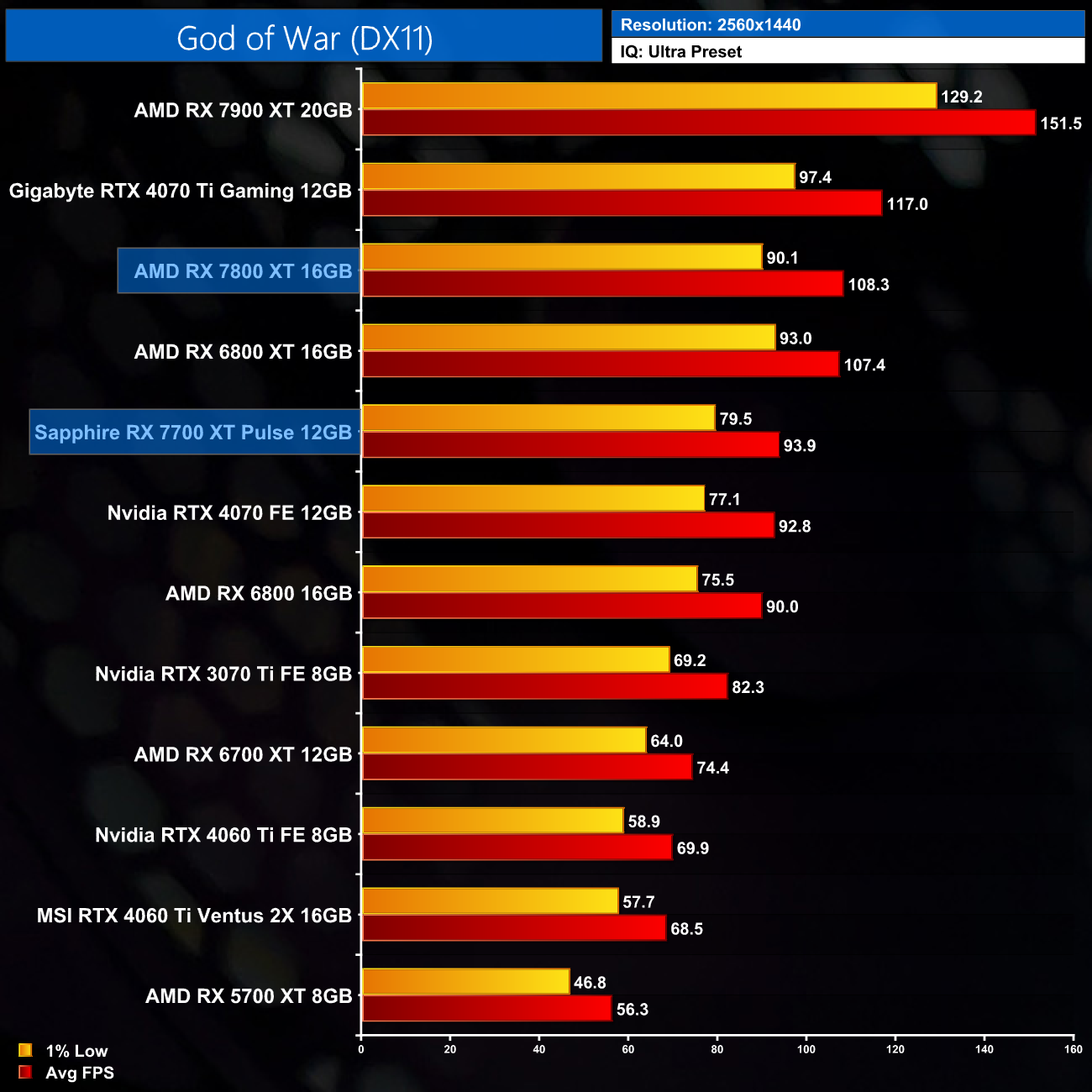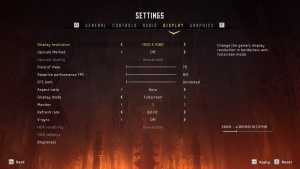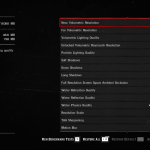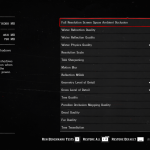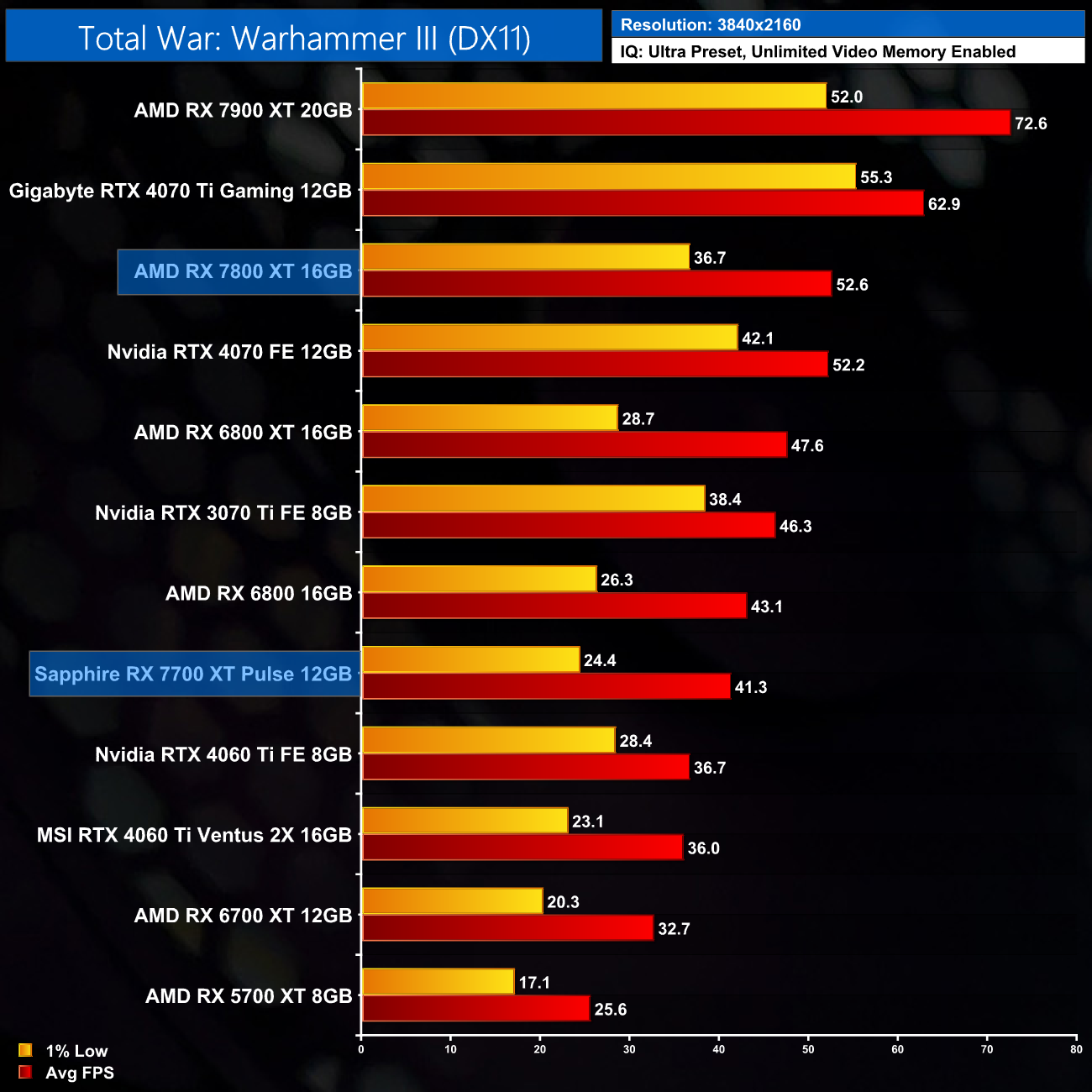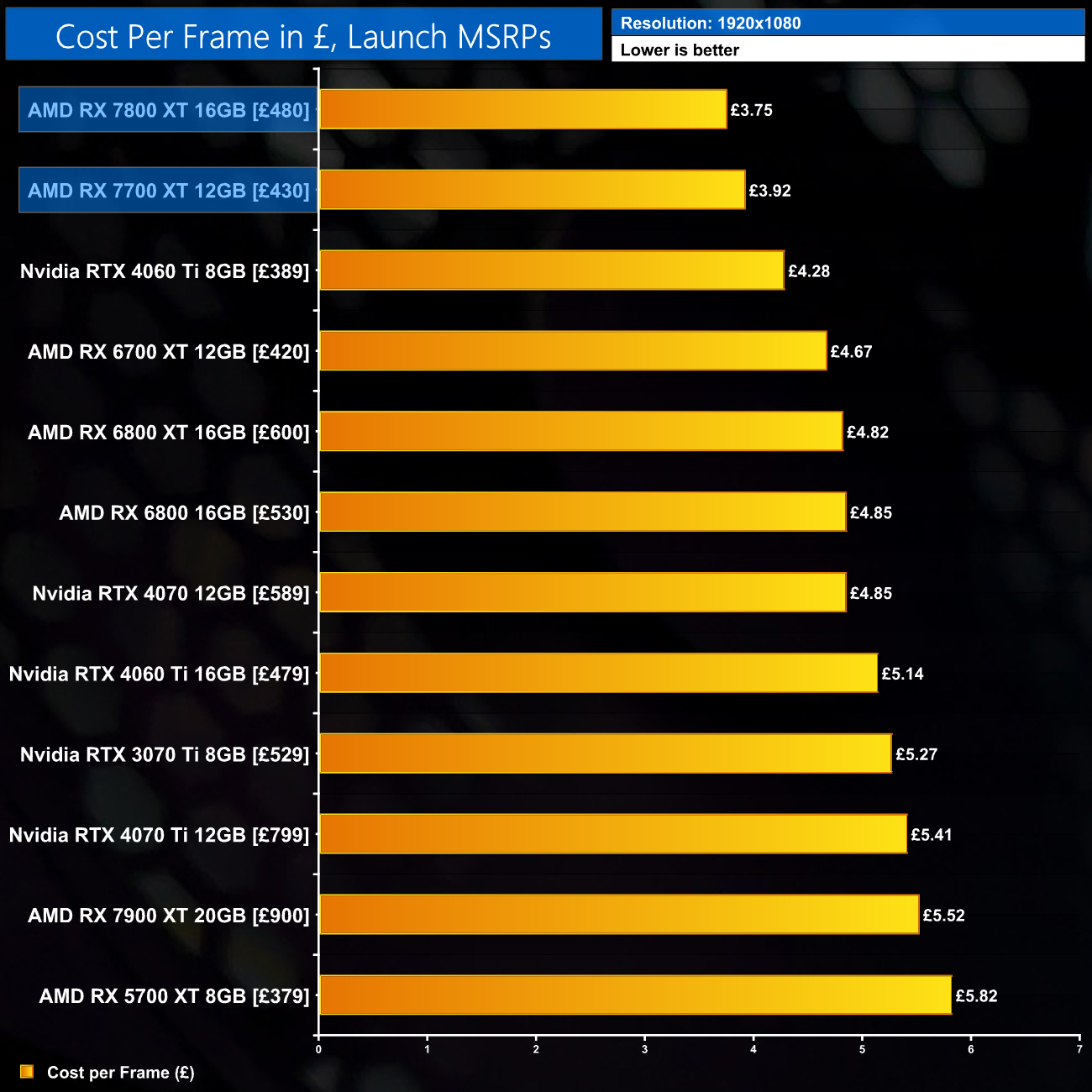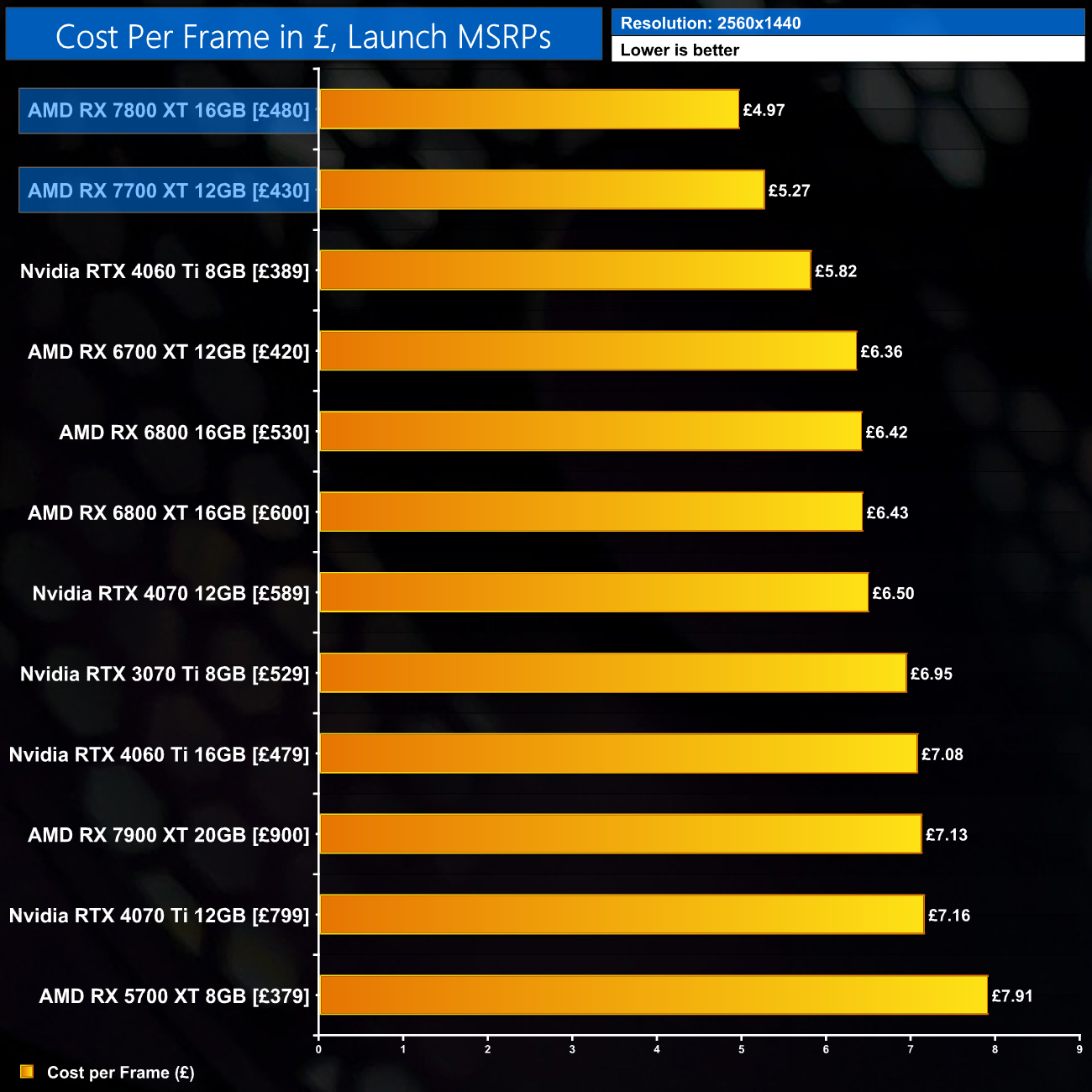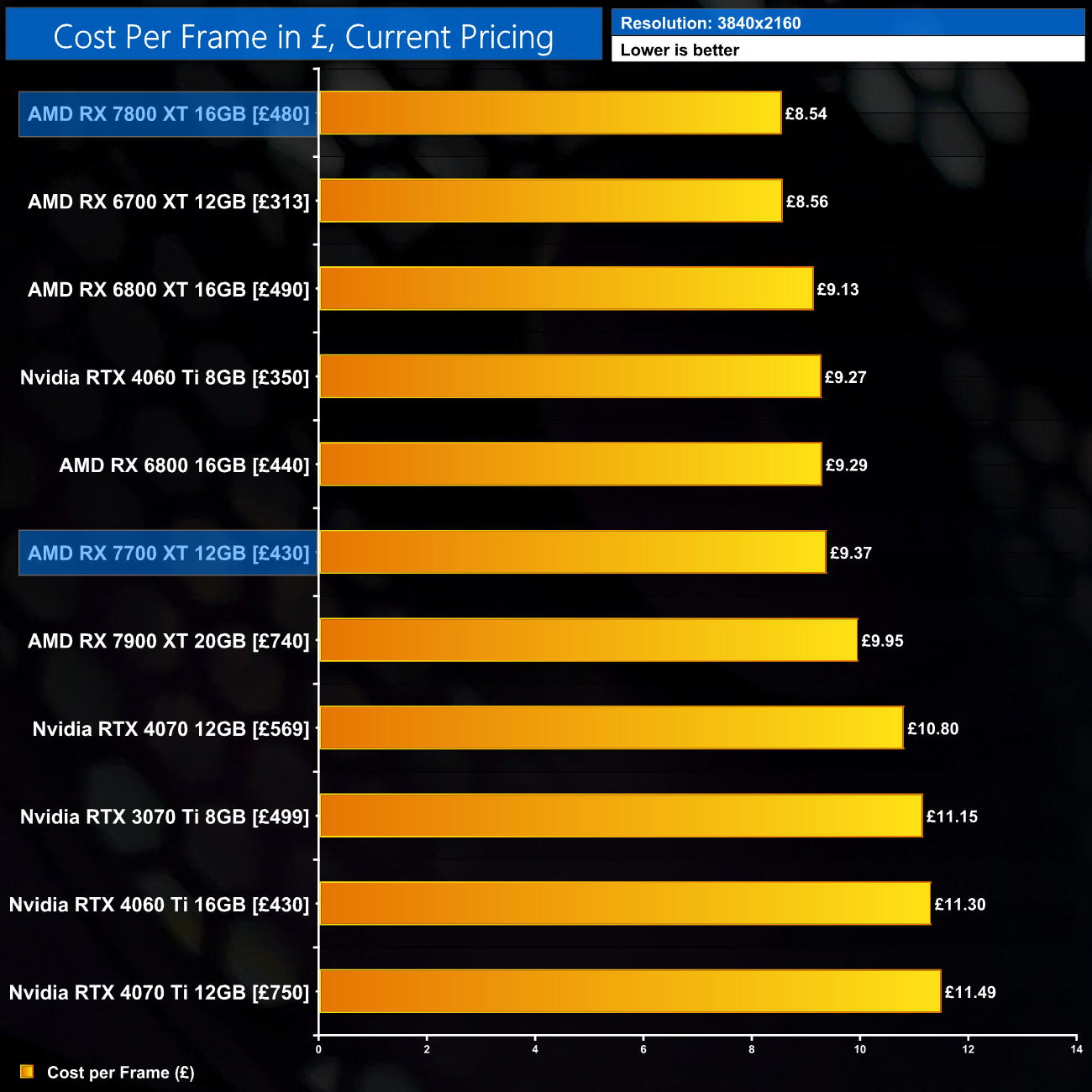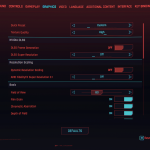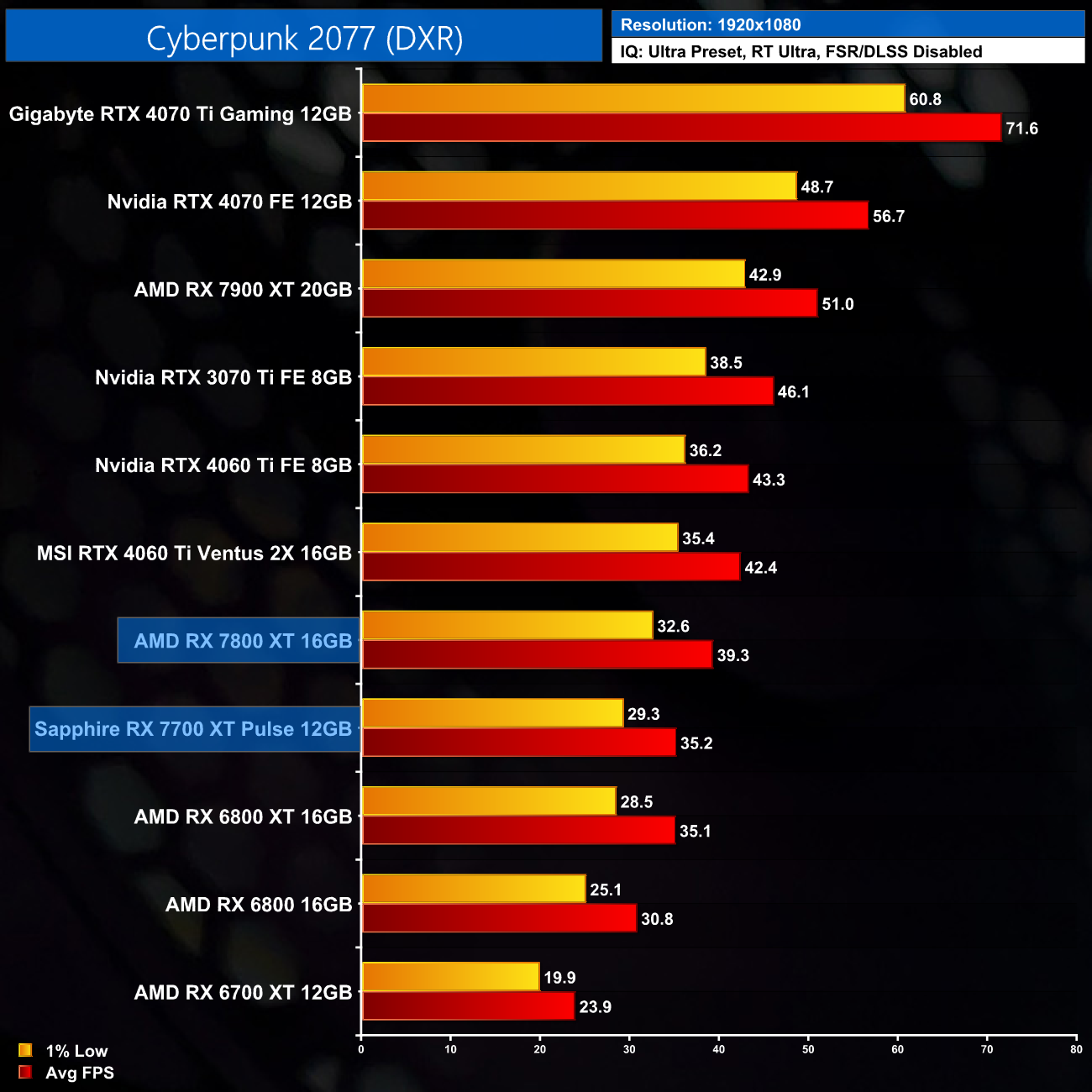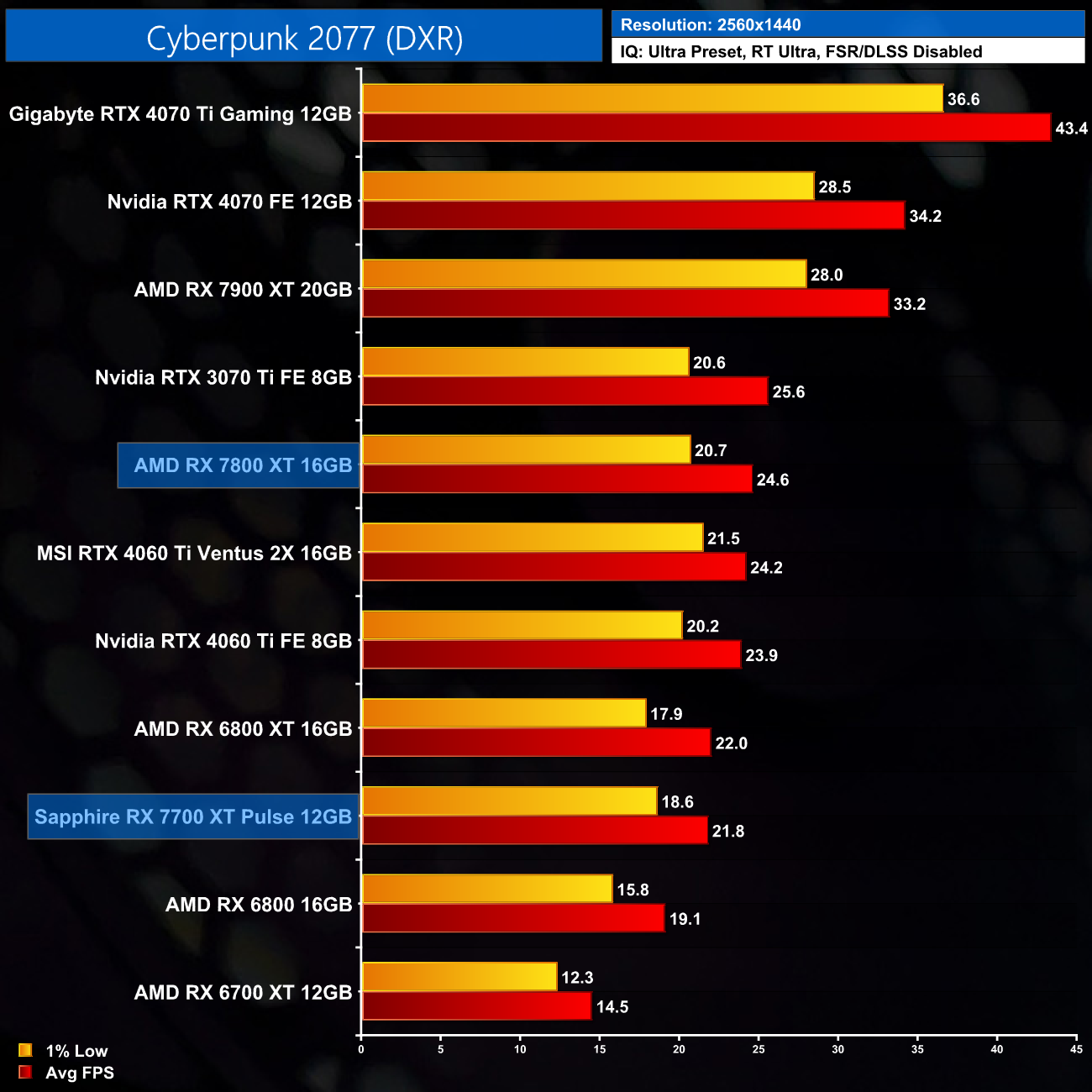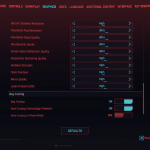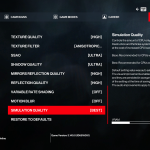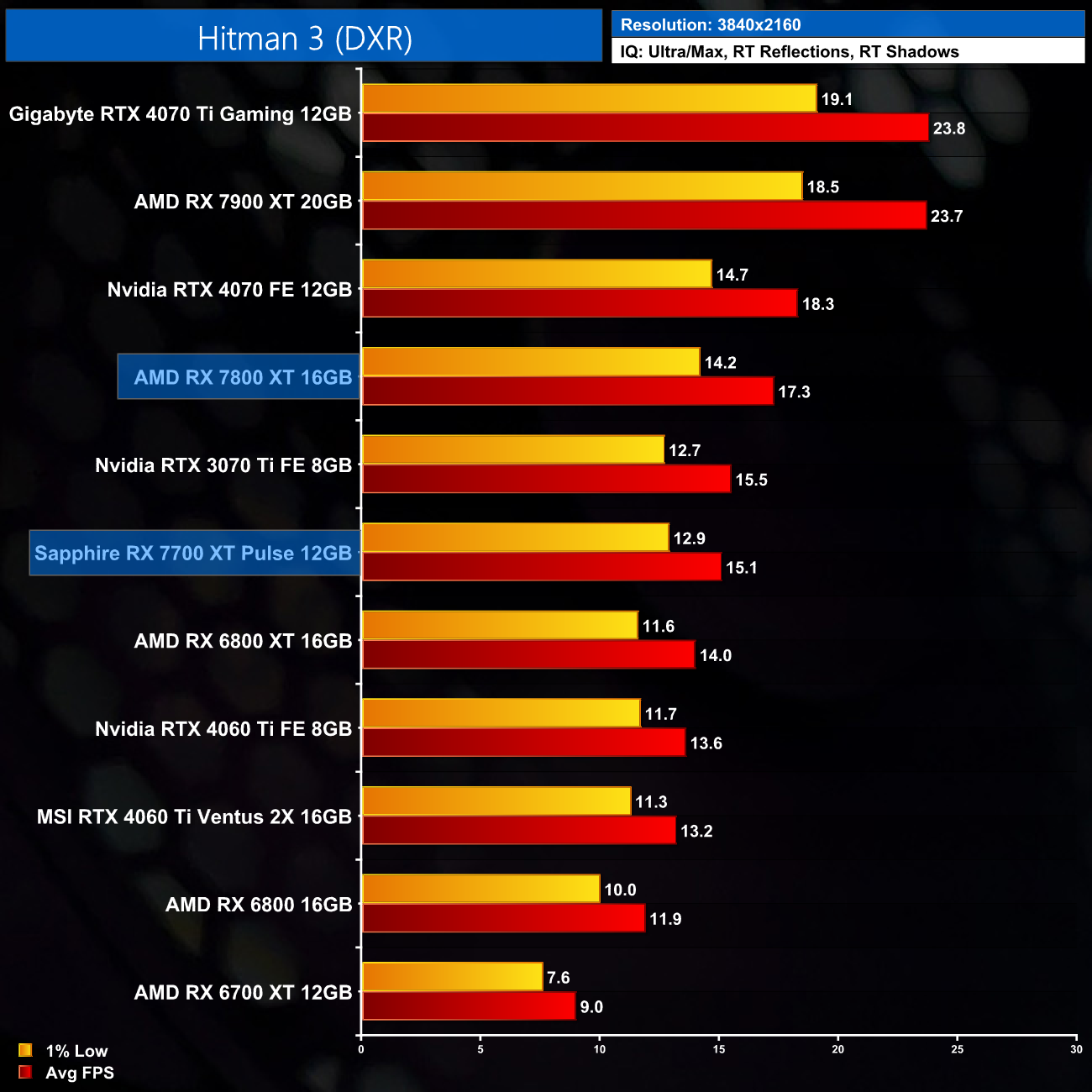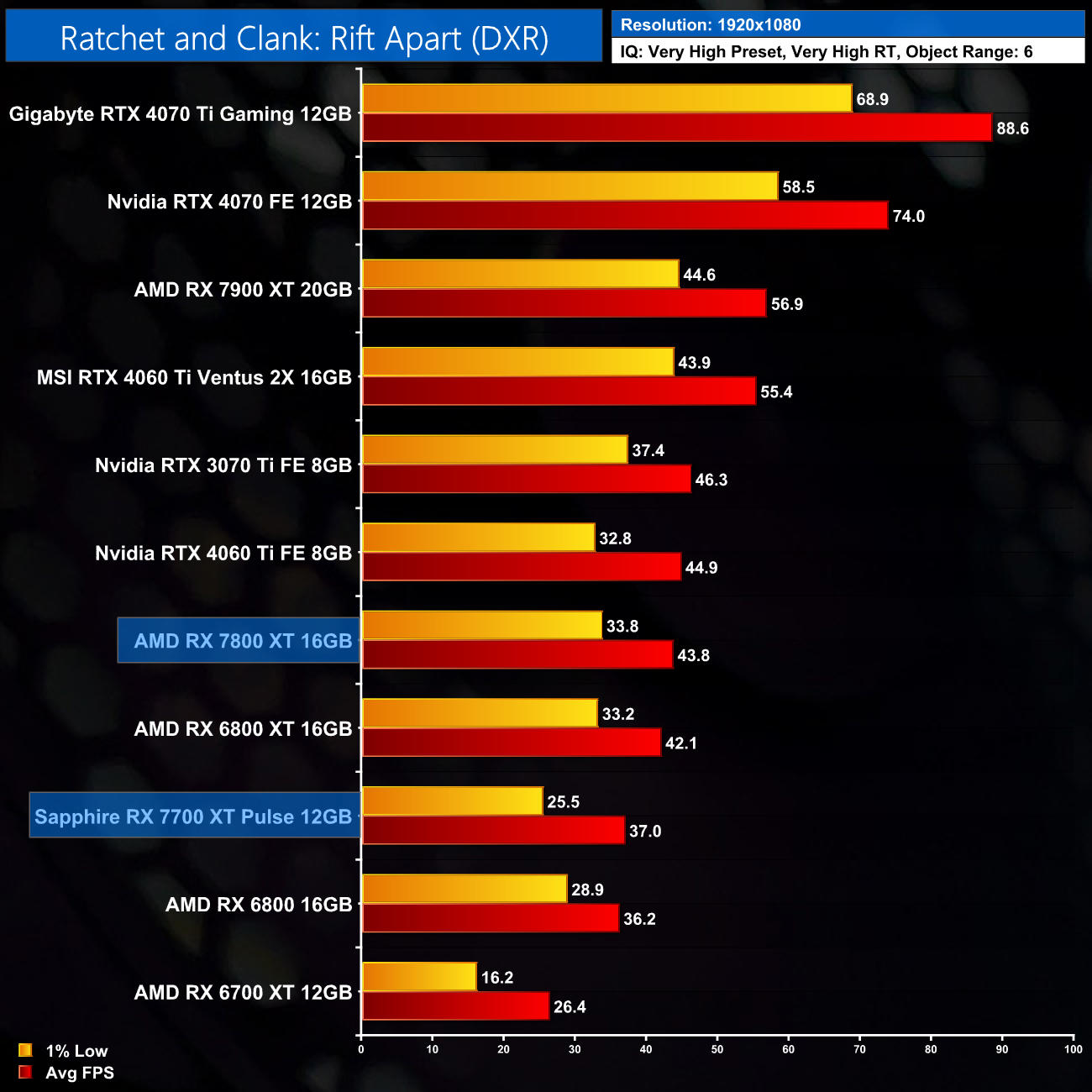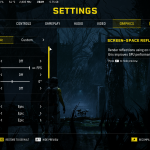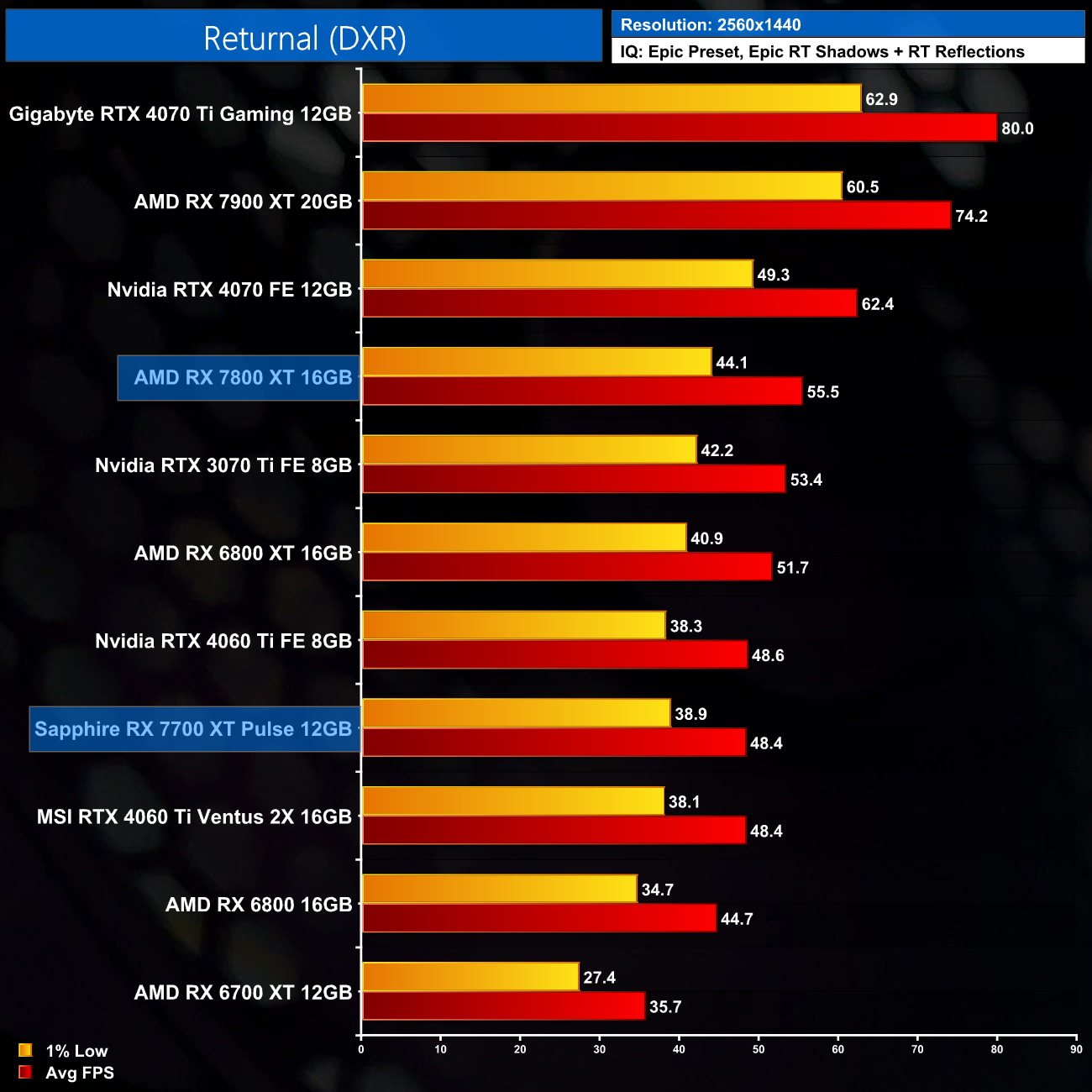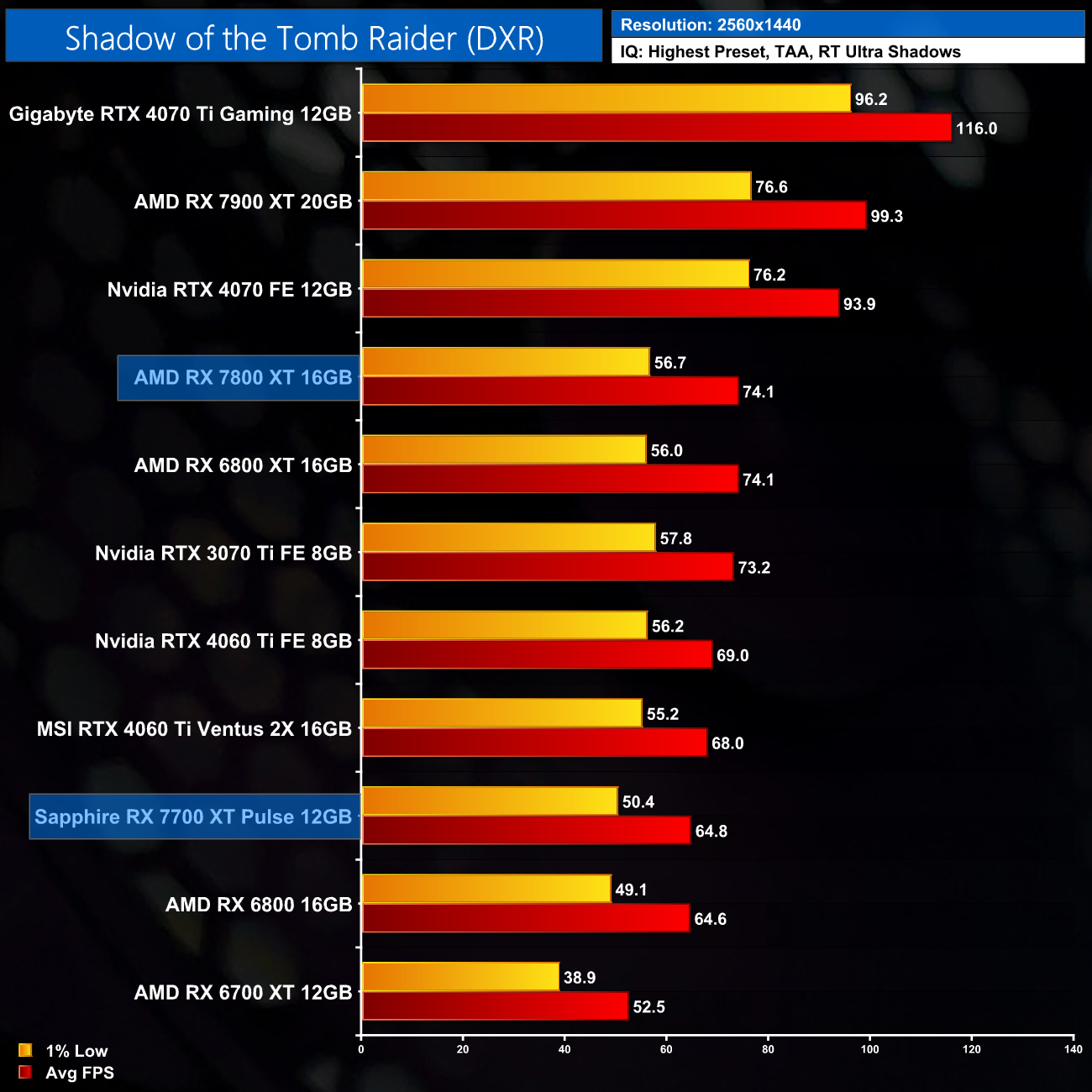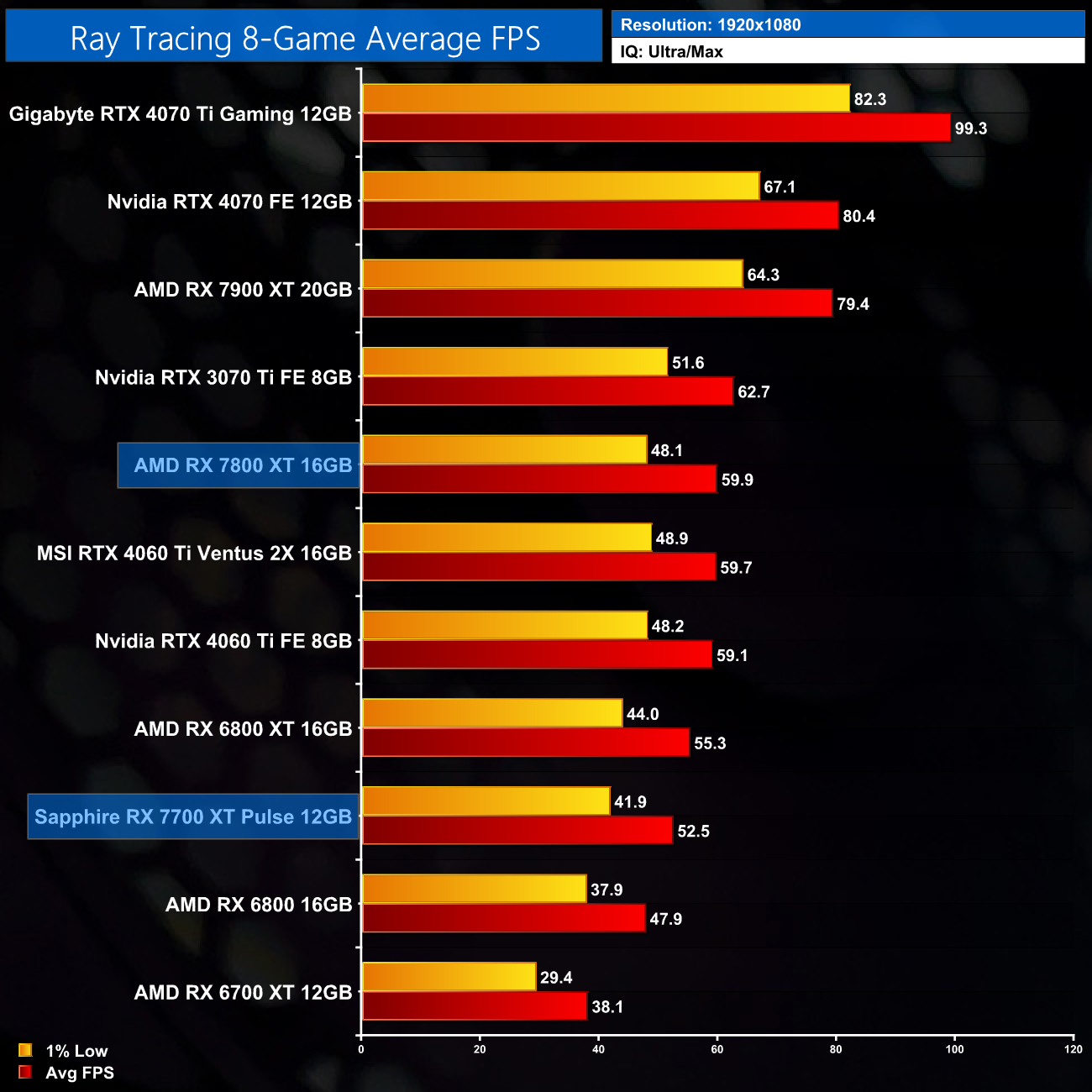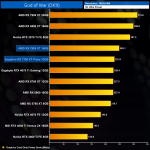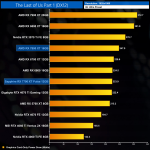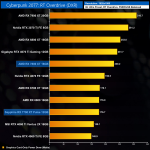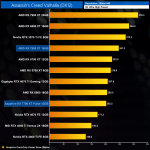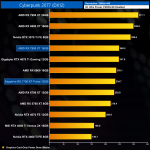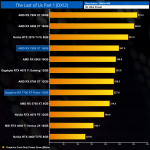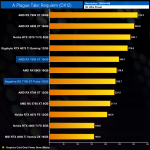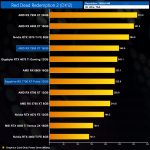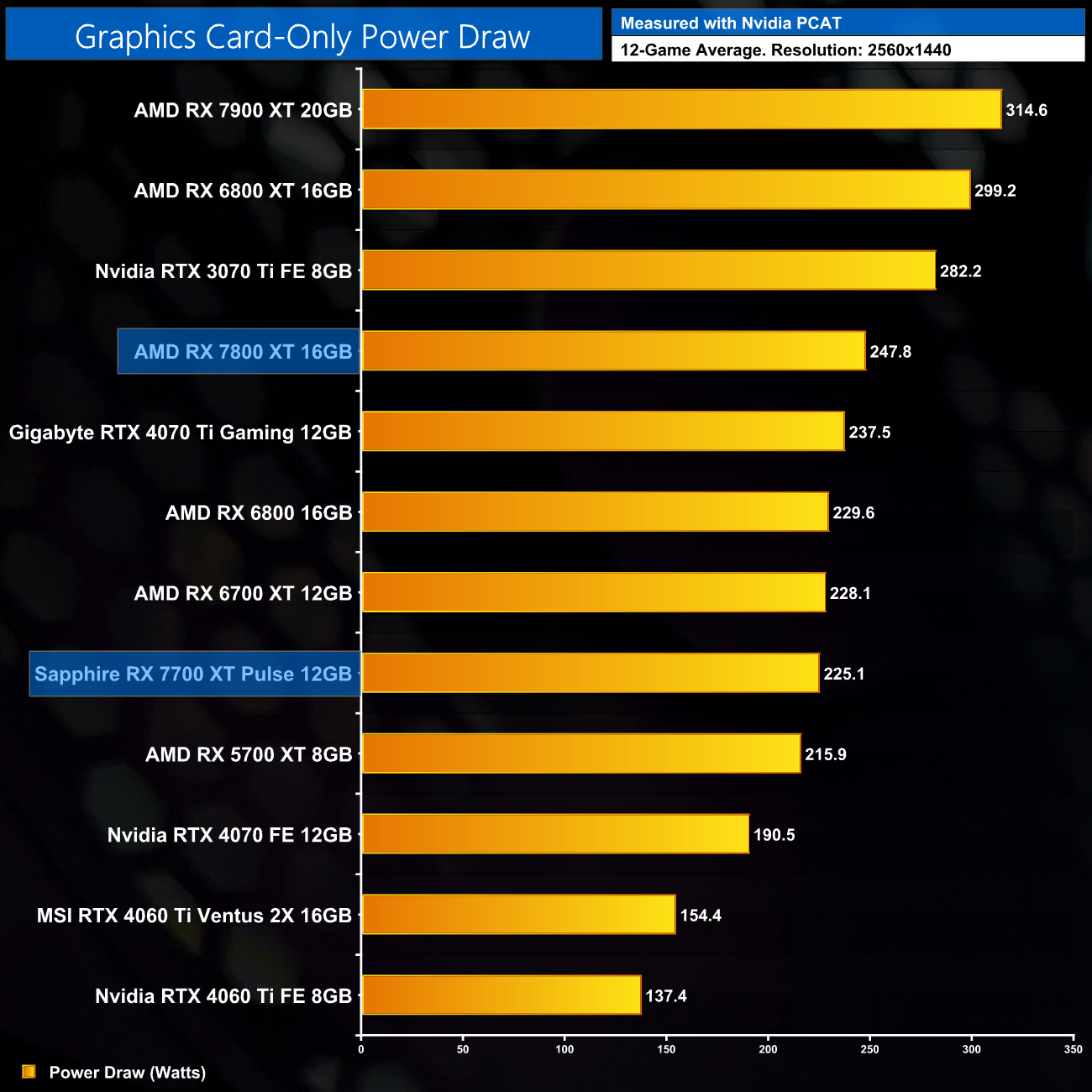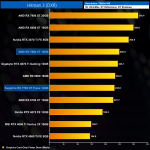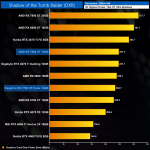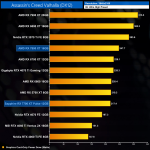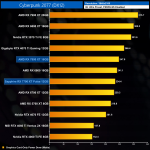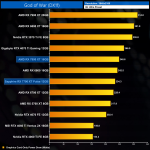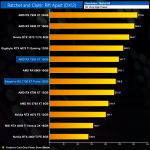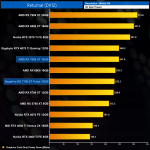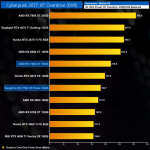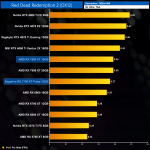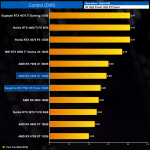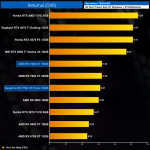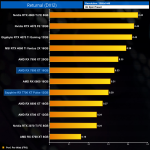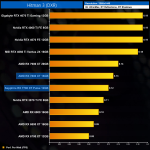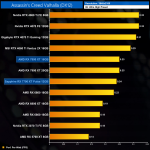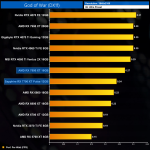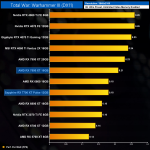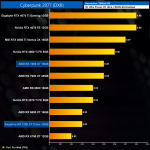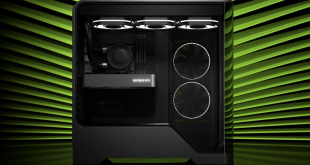
Less than two weeks on from their announcement at Gamescom 2023, today marks the release of AMD's new mid-range GPUs, the RX 7700 XT and the RX 7800 XT. This review will focus on the former card, though we do have a separate analysis of the RX 7800 XT if you want to read that. Utilising a cut-down implementation of AMD's Navi 32 chiplet-based silicon, the RX 7700 XT lands at £429.99, with AMD positioning it head-to-head against the RTX 4060 Ti 16GB. Today we find out which of these mid-range GPUs will come out on top…
Unlike the RX 7800 XT, which isn't necessarily a direct successor to the RX 6800 XT, AMD's new RX 7700 XT is a clear continuation from the RX 6700 XT. Both launched at around the same price, with the RX 7700 XT just £10 more expensive in terms of MSRP, while they both slot neatly into the mid-tier of AMD's existing offerings.
Despite the RTX 4060 Ti 16GB initially launching at £479, cards are already available at just £430, making this a straight shoot-out between the two GPUs. We test twelve games, plus another eight with ray tracing enabled, while also focusing on power draw and efficiency in today's review.
If you want to read this review as a single page, click HERE.
| RX 7900 XT | RX 7800 XT | RX 7700 XT | RX 6800 XT | RX 6800 | RX 6700 XT | |
| Architecture | RDNA 3 | RDNA 3 | RDNA 3 | RDNA 2 | RDNA 2 | RDNA 2 |
| Manufacturing Process | 5nm GCD + 6nm MCD | 5nm GCD + 6nm MCD | 5nm GCD + 6nm MCD | 7nm | 7nm | 7nm |
| Transistor Count | 57.7 billion | 28.1 billion | 28.1 billion | 26.8 billion | 26.8 billion | 17.2 billion |
| Die Size | 300 mm² GCD
220 mm² MCD |
200 mm² GCD
150 mm² MCD |
200 mm² GCD
150 mm² MCD |
519 mm² | 519 mm² | 336 mm² |
| Compute Units | 84 | 60 | 54 | 72 | 60 | 40 |
| Ray Accelerators | 84 | 60 | 54 | 72 | 60 | 40 |
| Stream Processors | 5376 | 3840 | 3456 | 4608 | 3840 | 2560 |
| Game GPU Clock | Up to 2000 MHz | 2124 MHz | 2171 MHz | Up to 2015MHz | Up to 1815MHz | Up to 2424MHz |
| Boost GPU Clock | Up to 2400 MHz | Up to 2430 MHz | Up to 2544 MHz | Up to 2250MHz | Up to 2105MHz | Up to 2581MHz |
| ROPs | 192 | 96 | 96 | 128 | 96 | 64 |
| AMD Infinity Cache | 80MB | 64MB | 48MB | 128MB | 128MB | 96MB |
| Memory | 20GB GDDR6 20Gbps | 16GB GDDR6 19.5 Gbps | 12GB GDDR6 18Gbps | 16GB GDDR6 16Gbps | 16GB GDDR6 16Gbps | 12GB GDDR6 16Gbps |
| Memory Bandwidth | 800 GB/s | 624 GB/s | 432 GB/s | 512 GB/s | 512 GB/s | 384 GB/s |
| Memory Interface | 320-bit | 256-bit | 192-bit | 256-bit | 256-bit | 192-bit |
| Board Power | 315W | 263W | 245W | 300W | 250W | 230W |
First, let's take a quick look at the specs. Unlike the most recent RDNA 3 GPU – the RX 7600 – AMD has made a return to its chiplet-based design for the RX 7700 XT, as we initially saw last year with the RX 7900 XTX and 7900 XT. This time around, the 7700 XT offers a 200mm² Graphics Compute Die (GCD) using TSMC's 5nm process, flanked by four 150 mm² Memory Compute Dies (MCDs) built on TSMC's 6nm node. One of those MCDs is disabled however, as the 7700 XT is not a full implementation of Navi 32.
Internally though, the compute makeup hasn't been radically changed. The cut-down Navi 32 silicon deployed here packs in 54 Compute Units, each of which houses 64 Stream Processors, for a total of 3456 shaders. There's also 54 Ray Accelerators – one per CU – and 96 ROPs.
As for clock speed, this remains high with the RX 7700 XT, with AMD touting a boost of up to 2544MHz, though a slightly lower game clock of 2171MHz.
Meanwhile, the memory configuration is almost identical to the previous generation RX 6700 XT. We still find 12GB GDDR6 operating over a 192-bit interface, but this time the memory clocks in at 18Gbps, up from 16Gbps. This gives a memory bandwidth of 432 GB/s, though AMD claims an ‘effective' bandwidth of 1995.3 GB/s due to the 64MB of 2nd Gen Infinity cache.
Power draw for the RX 7700 XT is rated at 245W Total Board Power (TBP), though AMD pointed out to us that this is an ‘up to' figure. We are using our well-established GPU power testing methodology in this review, so read on for our most detailed power and efficiency testing yet.
The Sapphire RX 7700 XT Pulse ships in a bright purple box, with a large AMD Radeon logo and 7700 XT branding in the bottom corner. Inside, the only included accessory was a short quick installation guide.
As for the design of the card, it's very reminiscent of the RX 7900 XT Pulse I recently used in a 44-game benchmark. Its shroud is made of mostly black plastic, though there are a few red accents which tie in with the Pulse colour scheme.
We can also note the dual fan cooler, using Sapphire's Angular Velocity Fan Blades, while each fan measures in at 100mm in diameter.
The Pulse is slightly larger than the RX 7800 XT reference card, with the following official dimensions provided by Sapphire: 280 x 128.75 x 52.57mm. It's by no means huge and should still fit in pretty much any mid-tower chassis these days. It weighs in at just over 1KG on my scales.
The side of the card is home to the Radeon and Sapphire logos, again coloured red. We can also note the full-length metal backplate, with the Pulse branding and an ECG printed in red – a staple of the Pulse series throughout the years.
Despite marginally lower power requirements than the RX 7800 XT, power is still delivered by two 8-pin connectors.
Display outputs consist of 2x HDMI 2.1 and 2x DisplayPort 2.1, so there's an extra HDMI but one less DisplayPort than what we usually see.
Driver Notes
- AMD GPUs (except RX 7800 XT and RX 7700 XT) were benchmarked with the Adrenalin 23.8.1 driver.
- AMD's RX 7800 XT and RX 7700 XT were benchmarked with the Adrenalin 23.20.01.05 driver supplied to press.
- All Nvidia GPUs were benchmarked with the 537.13 driver.
Result are only directly comparable where this exact configuration has been used.
Test System:
We test using a custom built system from PCSpecialist, based on Intel’s Rocket Lake platform. You can read more about this system HERE and configure your own PCSpecialist system HERE.
| CPU |
Intel Core i9-13900KS
|
| Motherboard |
Gigabyte Z790 Gaming X AX
|
| Memory |
32GB (2x16GB) Corsair Dominator Platinum RGB DDR5 6000MHz
|
| Graphics Card |
Varies
|
| SSD |
4TB Seagate Firecuda 530 Gen 4 PCIe NVMe
|
| Chassis | Corsair 5000D Airflow Tempered Glass Gaming Case |
| CPU Cooler |
Corsair iCUE H150i Elite RGB High Performance CPU Cooler
|
| Power Supply |
Corsair 1600W Pro Series Titanium AX1600i Digital Modular PSU
|
| Operating System |
Windows 11 22H2
|
| Monitor |
MSI Optix MPG321UR-QD
|
| Resizable BAR |
Enabled for all supported GPUs
|
Comparison Graphics Cards List
- AMD RX 7900 XT 20GB
- AMD RX 6800 XT 16GB
- AMD RX 6800 16GB
- AMD RX 6700 XT 12GB
- AMD RX 5700 XT 8GB
- Gigabyte RTX 4070 Ti Gaming 12GB
- Nvidia RTX 4070 FE 12GB
- MSI RTX 4060 Ti Ventus 2X 16GB
- Nvidia RTX 4060 Ti FE 8GB
- Nvidia RTX 3070 Ti FE 8GB
All cards were tested at reference specifications.
Software and Games List
- 3DMark Fire Strike & Fire Strike Ultra (DX11 Synthetic)
- 3DMark Time Spy (DX12 Synthetic)
- 3DMark DirectX Raytracing feature test (DXR Synthetic)
- Assassin's Creed Valhalla (DX12)
- Control (DX12)
- Cyberpunk 2077 (DX12)
- F1 23 (DX12)
- Forza Horizon 5 (DX12)
- God of War (DX11)
- Hitman 3 (DX12)
- Horizon Zero Dawn (DX12)
- The Last of Us Part 1 (DX12)
- A Plague Tale: Requiem (DX12)
- Ratchet and Clank: Rift Apart (DX12)
- Red Dead Redemption 2 (DX12)
- Resident Evil 4 (DX12)
- Returnal (DX12)
- Shadow of the Tomb Raider (DX12)
- Total War: Warhammer III (DX11)
We run each benchmark/game three times, and present mean averages in our graphs. We use FrameView to measure average frame rates as well as 1% low values across our three runs.
Fire Strike is a showcase DirectX 11 benchmark for modern gaming PCs. Its ambitious real-time graphics are rendered with detail and complexity far beyond other DirectX 11 benchmarks and games. Fire Strike includes two graphics tests, a physics test and a combined test that stresses the CPU and GPU. (UL).
3DMark Time Spy is a DirectX 12 benchmark test for Windows 10 gaming PCs. Time Spy is one of the first DirectX 12 apps to be built the right way from the ground up to fully realize the performance gains that the new API offers. With its pure DirectX 12 engine, which supports new API features like asynchronous compute, explicit multi-adapter, and multi-threading, Time Spy is the ideal test for benchmarking the latest graphics cards. (UL).
Kicking things off with our three 3DMark benchmarks, the RX 7700 XT delivers some decent results. It's very closely matched with the RX 6800 across all three tests, while it delivers a 30% uplift over the RX 6700 XT in Time Spy.
Real-time ray tracing is incredibly demanding. The latest graphics cards have dedicated hardware that’s optimized for ray-tracing. The 3DMark DirectX Raytracing feature test measures the performance of this dedicated hardware. Instead of using traditional rendering techniques, the whole scene is ray-traced and drawn in one pass. The result of the test depends entirely on ray-tracing performance. (UL).
As for the 3DMark DXR feature test, here the 7700 XT takes a 7% lead over the RX 6800, while it's 21% slower than the RTX 4060 Ti 16GB.
Assassin's Creed Valhalla is an action role-playing video game developed by Ubisoft Montreal and published by Ubisoft. It is the twelfth major installment and the twenty-second release in the Assassin's Creed series, and a successor to the 2018's Assassin's Creed Odyssey. The game was released on November 10, 2020, for Microsoft Windows, PlayStation 4, Xbox One, Xbox Series X and Series S, and Stadia, while the PlayStation 5 version was released on November 12. (Wikipedia).
Engine: AnvilNext 2.0. We test using the Ultra High preset, DX12 API.
Our first game of the day is Assassin's Creed Valhalla, where at 1440p the RX 7700 XT delivers 90FPS, putting it level with the RX 6800. It's 13% faster than the RTX 4060 Ti 16GB and 20% ahead of the RX 6700 XT.
Up at 4K, we still get a reasonable 52FPS on average, which is a significant 19% lead over the 4060 Ti 16GB. It's also a 27% generational uplift versus the RX 6700 XT.
Cyberpunk 2077 is a 2020 action role-playing video game developed and published by CD Projekt. The story takes place in Night City, an open world set in the Cyberpunk universe. Players assume the first-person perspective of a customisable mercenary known as V, who can acquire skills in hacking and machinery with options for melee and ranged combat. Cyberpunk 2077 was released for Microsoft Windows, PlayStation 4, Stadia, and Xbox One on 10 December 2020. (Wikipedia).
Engine: REDengine 4. We test using the Ultra preset, FSR disabled, DX12 API.
Cyberpunk 2077 is a strong showing for the RX 7700 XT. At 1440p it delivers 73FPS and is not far behind the RX 6800 XT, while it outclasses the 4060 Ti 16GB and RX 6700 XT by 32% and 39%, respectively.
At 4K it can't hold above 30FPS, with the 1% lows dipping down to 29FPS, but this is with Ultra settings in a highly demanding title. It's still 39% faster than the 4060 Ti 16GB!
Forza Horizon 5 is a 2021 racing video game developed by Playground Games and published by Xbox Game Studios. The twelfth main instalment of the Forza series, the game is set in a fictionalised representation of Mexico. It was released on 9 November 2021 for Microsoft Windows, Xbox One, and Xbox Series X/S. (Wikipedia).
Engine: ForzaTech. We test using the Extreme preset, DX12 API.
Next is Forza Horizon 5, where at 1440p the RX 7700 XT is on-par with the RTX 3070 Ti 8GB. It only has a small 7% lead over the RTX 4060 Ti 16GB though, and is the same margin ahead of the RX 6700 XT.
At 4K, it does scale slightly better and still averages 66FPS. Here it's 13% ahead of its Nvidia rival, while it offers a 19% generational uplift.
God of War is an action-adventure game developed by Santa Monica Studio and published by Sony Interactive Entertainment (SIE). It was released worldwide on April 20, 2018, for the PlayStation 4 with a Microsoft Windows version released on January 14, 2022. (Wikipedia).
Engine: Sony Santa Monica in-house engine. We test using the Ultra preset, DX11 API.
God of War runs very well on the RX 7700 XT, it's even level with the RTX 4070 at 1440p and a whopping 37% faster than the RTX 4060 Ti 16GB.
At 4K it does fall away slightly, but we're still looking at a commanding 22% lead over the RTX 4060 Ti 16GB, while it offers 26% more performance compared to its direct predecessor.
Horizon Zero Dawn is an action role-playing game developed by Guerrilla Games and published by Sony Interactive Entertainment. The plot follows Aloy, a hunter in a world overrun by machines, who sets out to uncover her past. It was released for the PlayStation 4 in 2017 and Microsoft Windows in 2020. (Wikipedia).
Engine: Decima. We test using the Ultimate Quality preset, DX12 API.
The generational gains in Horizon Zero Dawn are again more muted, with the 7700 XT holding a 17% advantage over the RX 6700 XT at 1440p. It's also 7% slower than the RX 6800.
Stepping up to 4K doesn't change a whole lot, the 7700 XT is still pretty playable with an average FPS just below 60, while it's also 16% faster than the 4060 Ti 16GB.
The Last of Us Part I is a 2022 action-adventure game developed by Naughty Dog and published by Sony Interactive Entertainment. A remake of the 2013 game The Last of Us, it features revised gameplay, including enhanced combat and exploration, and expanded accessibility options. It was released for Microsoft Windows in March 2023. (Wikipedia).
Engine: Naughty Dog in-house engine. We test using the Ultra preset, DX12 API.
The RX 7700 XT delivers a solid 60FPS experience in The Last of Us Part 1, while it hands out a beating to the RTX 4060 Ti 16GB, outperforming it by 27%. We're looking at a 21% gain versus the RX 6700 XT while it's 5% slower than the RX 6800.
At 4K it can't keep the 1% lows above 30FPS so image quality settings would need to be adjusted, so we see the 7700 XT fall 14% behind the RX 6800.
A Plague Tale: Requiem is an action-adventure stealth game developed by Asobo Studio and published by Focus Entertainment. It is the sequel to A Plague Tale: Innocence (2019), and follows siblings Amicia and Hugo de Rune who must look for a cure to Hugo's blood disease in Southern France while fleeing from soldiers of the Inquisition and hordes of rats that are spreading the black plague. The game was released for Nintendo Switch, PlayStation 5, Windows, and Xbox Series X/S on 18 October 2022. (Wikipedia).
Engine: Asobo Studio in-house engine. We test using the Ultra preset, DX12 API.
Things are much better for the 7700 XT in A Plague Tale: Requiem. At 1440p it delivers 57FPS – it's a demanding title – but that makes it 26% faster than the RTX 4060 Ti 16GB and a 36% uplift over the RX 6700 XT.
Again up at 4K, it can't keep above 30FPS at all times with these settings, but it's more competitive against the RX 6800 and isn't too far off the RX 6800 XT.
Ratchet & Clank: Rift Apart is a 2021 third-person shooter platform game developed by Insomniac Games and published by Sony Interactive Entertainment for the PlayStation 5. It is the ninth main instalment in the Ratchet & Clank series and a sequel to Ratchet & Clank: Into the Nexus. Rift Apart was announced in June 2020 and was released on June 11, 2021. A Windows port by Nixxes Software was released on July 26, 2023. (Wikipedia).
Engine: Insomniac Games in-house engine. We test using the Very High preset, DX12 API.
Up next is Ratchet and Clank, a new addition to our test suite. At 1440p the RX 7700 XT is actually just behind the RX 7800 XT, showing there's not much of a gap between these two cards. It's not much faster than the 4060 Ti 16GB either, holding just a 7% lead.
That does increase up at 4K, where the 7700 XT becomes 9% faster, though it is 3% behind the RX 6800.
Red Dead Redemption 2 is a 2018 action-adventure game developed and published by Rockstar Games. The game is the third entry in the Red Dead series and is a prequel to the 2010 game Red Dead Redemption. Red Dead Redemption 2 was released for the PlayStation 4 and Xbox One in October 2018, and for Microsoft Windows and Stadia in November 2019. (Wikipedia).
Engine: Rockstar Advance Game Engine (RAGE). We test by manually selecting Ultra settings (or High where Ultra is not available), TAA, DX12 API.
Red Dead Redemption 2 is another very healthy showing for the RX 7700 XT, as at 1440p it's only a couple of frames slower than the RTX 4070, despite being significantly cheaper. It's 29% faster than the 4060 Ti 16GB, too.
4K gaming is just about manageable here, provided you are happy with 40FPS or so, but that's still 31% more frames than the 4060 Ti 16GB, despite both GPUs priced at £430.
Resident Evil 4 is a 2023 survival horror game developed and published by Capcom. It is a remake of the 2005 game Resident Evil 4. Players control the US agent Leon S. Kennedy, who must save Ashley Graham, the daughter of the United States president, from the mysterious Los Illuminados cult. Resident Evil 4 was announced in June 2022 and released on PlayStation 4, PlayStation 5, Windows, and Xbox Series X/S on March 24, 2023.
Engine: RE Engine. We test using the Max preset with ray tracing disabled, DX12 API.
Resident Evil 4 is a very smooth experience at 1440p using the RX 7700 XT, with an average of 98FPS, it's only 7% slower than the RTX 4070 but 28% faster than the 4060 Ti 16GB, while it also offers a similar boost over the RX 6700 XT.
4K is playable too at maximum settings, though ray tracing is disabled, as the 7700 XT delivers 55FPS on average. This puts it just 3% behind the RX 6800, while it's again 30% faster than the RX 6700 XT.
Returnal is a 2021 roguelike video game developed by Housemarque and published by Sony Interactive Entertainment. It was released for the PlayStation 5 on April 30, 2021 and Windows on February 15, 2023. The game follows Selene Vassos, an astronaut who lands on the planet Atropos in search of the mysterious “White Shadow” signal and finds herself trapped in a time loop. (Wikipedia).
Engine: Unreal Engine 4. We test using the Epic preset with ray tracing disabled, DX12 API.
In Returnal, the RX 7700 XT finds itself in a 3-way tie with the RX 6800 and RTX 3070 Ti, while it still convincingly beats the RTX 4060 Ti 16GB at 1440p, with an 18% margin of victory.
Up at 4K, It just about holds the 1% lows above 30FPS, delivering a 30% gain over the RX 6700 XT in the process.
Total War: Warhammer III is a turn-based strategy and real-time tactics video game developed by Creative Assembly and published by Sega. It is part of the Total War series, and the third to be set in Games Workshop's Warhammer Fantasy fictional universe (following 2016's Total War: Warhammer and 2017's Total War: Warhammer II). The game was announced on February 3, 2021 and was released on February 17, 2022.(Wikipedia).
Engine: TW Engine 3 (Warscape). We test using the Ultra preset, with unlimited video memory enabled, DX11 API.
Lastly we come to Total War: Warhammer III. Once more at 1440p, things are very closely matched between the RX 7700 XT, RX 6800 and RTX 3070 Ti at 1440p. The RX 7700 XT is 27% faster than its predecessor however, while it comes in 17% ahead of the 4060 Ti 16GB.
Up at 4K, the 1% lows drop off on most AMD cards, but the 7700 XT remains competitive with the RX 6800, while still coming in 15% more than its Nvidia counterpart.
Here we present frame rate figures for each graphics card, averaged across all 12 games on test today. These figures can disguise significant variations in performance from game to game, but provide a useful overview of the sort of performance you can expect at each resolution tested.
Over the 12 games tested, performance of the RX 7700 XT is highly competitive with the RX 6800 – in fact, at 1440p there's barely a 1% difference between the two. It comes in 23% faster versus the RX 6700 XT, while it's 21% faster than the similarly-priced RTX 4060 Ti 16GB.
4K is more of a challenge and the 7700 XT can't always get the job done at Ultra settings, but it's still 21% faster than the 4060 Ti 16GB on average, while it delivers a 25% uplift compared to the RX 6700 XT.
It's worth taking a closer look at the performance versus the RTX 4060 Ti 16GB – this shows the margins between the two GPUs at 1440p over all 12 games tested.
At worst, the RX 7700 XT is 7% faster than the RTX 4060 Ti 16GB, but 10 of the 12 games tested show at least a 10% lead for the AMD GPU. In fact, in half of the games tested it was more than 25% faster than its Nvidia rival, despite both GPU retailing for £430.
The MSRPs
Using the average frame rate data presented earlier in the review, here we look at the cost per frame using the UK MSRP launch prices for each GPU.
Cost per frame based on the MSRP pricing is competitive. The main question mark is that the RX 7700 XT is slightly worse value than the RX 7800 XT also launching today, which is unusual considering the cheaper card usually offers more value – that's not the case here. Still, at 1440p its MSRP equates to a 17% reduction in cost per frame compared to the RX 6700 XT, while it's 19% cheaper per frame than the RTX 4060 Ti 16GB.
Current retail pricing
Current retail prices do paint a slightly different picture. At 1440p for instance, the 7700 XT is slightly worse value than the RX 6700 XT, which I've seen for less than £320 – it's 11% more expensive per frame. It is still better value than the 4060 Ti 16GB at £430 though, offering 17% better value.
Starfield is an action role-playing game developed by Bethesda Game Studios and published by Bethesda Softworks.[4] It was announced during Bethesda's E3 presentation in 2018.[4] The game takes place in a space-themed setting, and is the first new intellectual property developed by Bethesda in 29 years.[5] It is scheduled to release for Windows and Xbox Series X/S on September 6, 2023.
Engine: Creation Engine 2. We test using the Ultra preset, with FSR and VRS disabled, DX12 API.
Just before we get into our ray tracing results, as a bonus I tested just 4 GPUs in Starfield. I would have loved to test more but simply ran out of time after re-testing all the GPUs for this review with the latest drivers – but I still wanted to show performance of the new GPUs in this title.
At 1440p, the RX 7700 XT isn't able to maintain 60FPS using Ultra settings in the New Atlantis area. it is, however, on-par with the RTX 4070 despite being priced significantly lower, and it comes in 38% faster than the RTX 4060 Ti 16GB. 4K is too heavy for the 7700 XT without adjusting image quality settings or enabling FSR, but performance is still on par with the RTX 4070 which is highly impressive.
Control is an action-adventure game developed by Remedy Entertainment and published by 505 Games. The game was released in August 2019 for PlayStation 4, Windows, and Xbox One, and for PlayStation 5 and Xbox Series X/S in February 2021. (Wikipedia).
Engine: Northlight Engine. We test using the High Preset, High Ray Tracing Preset, DXR API. DLSS/FSR are disabled.
Starting our ray tracing benchmarks with Control, the RX 7700 XT delivers a decent experience at 1080p, with an average of 61FPS. That's a healthy 33% uplift versus the RX 6700 XT and it's even a smidge ahead of the RTX 4060 Ti 16GB.
Cyberpunk 2077 is a 2020 action role-playing video game developed and published by CD Projekt. The story takes place in Night City, an open world set in the Cyberpunk universe. Players assume the first-person perspective of a customisable mercenary known as V, who can acquire skills in hacking and machinery with options for melee and ranged combat. Cyberpunk 2077 was released for Microsoft Windows, PlayStation 4, Stadia, and Xbox One on 10 December 2020. (Wikipedia).
Engine: REDengine 4. We test using the Ray Tracing: Ultra preset. DLSS/FSR are disabled. DXR API.
Cyberpunk 2077, using the RT Ultra preset, tells a different story. Not only is the RX 7700 XT 16% slower than the RTX 4060 Ti 16GB, it can't hold above 30FPS at 1080p. Even though it's a rather hefty 47% faster than the RX 6700 XT, it doesn't mean a whole lot at this frame rate.
Cyberpunk 2077 is a 2020 action role-playing video game developed and published by CD Projekt. The story takes place in Night City, an open world set in the Cyberpunk universe. Players assume the first-person perspective of a customisable mercenary known as V, who can acquire skills in hacking and machinery with options for melee and ranged combat. Cyberpunk 2077 was released for Microsoft Windows, PlayStation 4, Stadia, and Xbox One on 10 December 2020. (Wikipedia).
Engine: REDengine 4. We test using the RT Overdrive preset. DLSS/FSR/XeSS are set to their Balanced modes. DXR API.
As expected, the RX 7700 XT looks even worse in Cyberpunk 2077 when we enable RT Overdrive path tracing. Even with FSR Balanced, it crumples to just 18FPS at 1080p and is 63% slower than the RTX 4060 Ti 16GB.
F1 23 is a racing video game developed by Codemasters and published by EA Sports. It is the sixteenth entry in the F1 series by Codemasters. It holds the official licence for the 2023 Formula One and Formula 2 championships. The game was released for Microsoft Windows, PlayStation 4, PlayStation 5, Xbox One, Xbox Series X/S, and Linux (through Valve's Proton compatibility layer) on 16 June 2023. (Wikipedia).
Engine: EGO. We test using the Ultra High preset, High ray tracing quality, DXR API. DLSS/FSR are disabled.
F1 23, on the other hand, actually sees the RX 7700 XT outperforming the RTX 4060 Ti 16GB by a not insignificant margin – it's 14% faster at 1080p and delivers 67FPS on average. That also makes it a whopping 55% faster than its predecessor – not a bad generational uplift!
Hitman 3 is a 2021 stealth game developed and published by IO Interactive. Hitman 3 was released worldwide for PlayStation 4, PlayStation 5, Windows, Xbox One, Xbox Series X/S, Stadia, and Nintendo Switch (via cloud gaming) on 20 January 2021. (Wikipedia).
Engine: Glacier engine. We test using Ultra settings, RT Reflections, RT Shadows, DXR API. DLSS/FSR are disabled.
Hitman 3 is definitely heavier than F1 23, and the 7700 XT only manages 42FPS at 1080p, putting it roughly level with the 4060 Ti 16GB. Once more though, it is 54% faster than the RX 6700 XT which is a pretty tidy gain over the last-gen card.
Ratchet & Clank: Rift Apart is a 2021 third-person shooter platform game developed by Insomniac Games and published by Sony Interactive Entertainment for the PlayStation 5. It is the ninth main installment in the Ratchet & Clank series and a sequel to Ratchet & Clank: Into the Nexus. Rift Apart was announced in June 2020 and was released on June 11, 2021. A Windows port by Nixxes Software was released on July 26, 2023. (Wikipedia).
Engine: Insomniac Games in-house engine. We test using the Very High preset, DX12 API.
Ratchet and Clank: Rift Apart is too much for the RX 7700 XT at 1080p however, and it loses heavily to the RTX 4060 Ti 16GB – by a 33% margin no less. AMD GPUs as a whole struggle in this title so perhaps it's no surprise the game launched with RT disabled for AMD GPUs.
Returnal is a 2021 roguelike video game developed by Housemarque and published by Sony Interactive Entertainment. It was released for the PlayStation 5 on April 30, 2021 and Windows on February 15, 2023. The game follows Selene Vassos, an astronaut who lands on the planet Atropos in search of the mysterious “White Shadow” signal and finds herself trapped in a time loop. (Wikipedia).
Engine: Unreal Engine 4. We test using the Epic preset with ray tracing disabled, DX12 API.
Returnal is very playable at 1080p however, with the 7700 XT delivering over 60FPS on average, and it's only 4% slower than the RTX 4060 Ti. This time it comes in 31% faster than the RX 6700 XT and it's 9% ahead of the RX 6800.
Shadow of the Tomb Raider is a 2018 action-adventure video game developed by Eidos-Montréal and published by Square Enix's European subsidiary. It continues the narrative from the 2015 game Rise of the Tomb Raider and is the twelfth mainline entry in the Tomb Raider series, as well as the third and final entry of the Survivor trilogy. The game was originally released worldwide for PlayStation 4, Windows, and Xbox One. (Wikipedia).
Engine: Foundation Engine. We test using the Highest Preset, 16x Anisotropic filtering, RT Ultra Shadows. DLSS/FSR are disabled. DXR API.
Finally we take a look at a classic from 2018, Shadow of the Tomb Raider. With just RT Shadows it is not too demanding and the RX 7700 XT is good for over 90FPS at 1080p, coming in 8% slower than the RTX 4060 Ti 16GB but 24% faster than the RX 6700 XT.
Ray tracing 8-game average FPS
On average, over 8 games, we can see that the RX 7700 XT is a pretty sizeable upgrade over its predecessor, delivering 38% more performance for ray tracing. It is still 12% slower than the RTX 4060 Ti, though the likes of Cyberpunk 2077 and Ratchet and Clank see heavy losses, while other games like F1 23 are more competitive.
Cost per frame, launch MSRP data
Based on those 8 ray traced games, we also include cost per frame for RT only. The RX 7700 XT isn't far off the RTX 4060 Ti 16GB in terms of MSRP pricing, but the top of the chart is dominated by Nvidia GPUs.
Cost per frame, current pricing data
That doesn't change a whole lot when using cost per frame based on current retail prices, though the RTX 4060 Ti 16GB is the better value card for ray tracing compared to the RX 7700 XT. It's not a massive disparity, but the RX 7700 XT is 14% more expensive per frame.
Here we present the average clock speed for each graphics card while running Cyberpunk 2077 for 30 minutes. We use GPU-Z to record the GPU core frequency during gameplay. We calculate the average core frequency during the 30 minute run to present here.
As we've only tested one RX 7700 XT as part of this day one review – the Sapphire Pulse – the average clock speed shown here is really just to lay the groundwork for our other upcoming partner card reviews. On its own it doesn't mean much, but we'll see how the likes of the PowerColor Hellhound and Gigabyte Gaming OC compare.
For our temperature testing, we measure the peak GPU core temperature under load. A reading under load comes from running Cyberpunk 2077 for 30 minutes.
Likewise, for the temperatures we have no point of comparison for the RX 7700 XT just yet, but the Sapphire Pulse did very well – the GPU temperature peaked at 63C, with the hot spot at 84C, both are solid results – it will be interesting to see how they compare to other cards!
We take our noise measurements with the sound meter positioned 1 foot from the graphics card. I measured the noise floor to be 32 dBA, thus anything above this level can be attributed to the graphics cards. The power supply is passive for the entire power output range we tested all graphics cards in, while all CPU and system fans were disabled. A reading under load comes from running Cyberpunk 2077 for 30 minutes.
The Pulse is whisper quiet, too. In our testing, the fans span up to just 26%, or 1150rpm, and it barely registered on our sound meter, with noise hitting just 32dBa. I'm also pleased to confirm that there was no audible coil whine during my testing.
Here we present power draw figures for the graphics card-only, on a per-game basis for all twelve games we tested at 1080p. This is measured using Nvidia's Power Capture Analysis Tool, also known as PCAT. You can read more about our updated power draw testing methodology HERE.
Per-Game Results at 1080p:
Click to enlarge.
12-Game Average at 1080p:
Despite AMD rating the RX 7700 XT with a Total Board Power draw of 245W (TBP), Sapphire's own product page offers a rated TBP of just 230W for the Pulse. At 1080p I found it to be below even this figure, with an average of 215.9W over the 12 games tested.
Ray tracing results
As a bonus, we now include the power figures for all eight games we test with ray tracing enabled.
8-Game ray tracing average:
Power did increase slightly in games with RT enabled, but only to an average of 221.2W.
Here we present power draw figures for the graphics card-only, on a per-game basis for all twelve games we tested at 1440p. This is measured using Nvidia's Power Capture Analysis Tool, also known as PCAT. You can read more about our updated power draw testing methodology HERE.
Per-Game Results at 1440p:
Click to enlarge.
12-Game Average at 1440p:
Increasing the resolution to 1440p sees a small increase in average power draw, as it hit 225.1W over the 12 games tested.
Ray tracing results
As a bonus, we now include the power figures for all eight games we test with ray tracing enabled.
8-Game ray tracing average:
This is a similar result to what we see with RT enabled at 1440p.
Here we present power draw figures for the graphics card-only, on a per-game basis for all twelve games we tested at 2160p (4K). This is measured using Nvidia's Power Capture Analysis Tool, also known as PCAT. You can read more about our updated power draw testing methodology HERE.
Per-Game Results at 2160p (4K):
Click to enlarge.
12-Game Average at 2160p (4K):
Lastly, at 4K the RX 7700 XT averaged just below 230W – 229.4W to be precise – so about 15W lower than AMD's rated 245W TBP.
Ray tracing results
As a bonus, we now include the power figures for all eight games we test with ray tracing enabled.
8-Game ray tracing average:
Power is a touch lower at 4K with RT enabled, this time averaging 218.6W.
Using the graphics card-only power draw figures presented earlier in the review, here we present performance per Watt on a per-game basis for all twelve games we tested at 1080p.
Per-Game Results at 1080p:
Click to enlarge.
12-Game Average at 1080p:
Combining the power draw and performance figures, we take a look at performance per Watt, starting at 1080p. The RX 7700 XT is roughly level with the RX 7800 XT and 7900 XT, in fact it is dead level with the RX 6800. That makes it 18% less efficient than the RTX 4060 Ti 16GB, or 25% behind the RTX 4070.
Ray tracing results
As a bonus, we now include the power figures for all eight games we test with ray tracing enabled.
8-Game ray tracing average:
As expected, the ray tracing figures are somewhat different, with Nvidia GPUs clearly being the most efficient for ray tracing workloads. The RX 7700 XT is now 41% and 45% less efficient than the 4060 Ti 16GB and RTX 4070, respectively.
Using the graphics card-only power draw figures presented earlier in the review, here we present performance per Watt on a per-game basis for all twelve games we tested at 1440p.
Per-Game Results at 1440p:
Click to enlarge.
12-Game Average at 1440p:
As for 1440p, not a whole lot has changed from the 1080p data. The RX 7700 XT is just a hair more efficient than the RX 6800 but is 16% behind the RTX 4060 Ti 16GB in this metric.
Ray tracing results
As a bonus, we now include the power figures for all eight games we test with ray tracing enabled.
8-Game ray tracing average:
Likewise for the RT results, we're looking at 40% lower performance per Watt than the 4060 Ti 16GB. It is still improved over the RX 6700 XT, by 36%, but can't match Ada Lovelace.
Using the graphics card-only power draw figures presented earlier in the review, here we present performance per Watt on a per-game basis for all twelve games we tested at 2160p (4K).
Per-Game Results at 2160p (4K):
Click to enlarge.
12-Game Average at 2160p (4K):
Lastly, at 4K the performance per Watt is now a touch behind the RX 7800 XT, coming 14% lower, while it's still about 17% worse than the RTX 4060 Ti 16GB.
Ray tracing results
As a bonus, we now include the power figures for all eight games we test with ray tracing enabled.
8-Game ray tracing average:
The same can be said at 4K with RT enabled – Nvidia is clear at the top of the chart.
We measure system-wide power draw from the wall while running Cyberpunk 2077 for 30 minutes. We do this at 1080p, 1440p and 2160p (4K) to give you a better idea of total system power draw across a range of resolutions, where CPU power is typically higher at the lower resolutions.
Total system power draw is the last area for us to look at today, with the RX 7700 XT hitting about 450W in Cyberpunk 2077. AMD officially recommends a 700W power supply.
Arriving at the same time as AMD's new RX 7800 XT, this review has focused on the slightly cheaper RX 7700 XT graphics card. Retailing for $449 MSRP, or £429.99 for UK buyers, it has Nvidia's RTX 4060 Ti 16GB firmly in its sights and frankly gives that GPU a bit of a pasting.
That was immediately evident when looking at our initial game benchmarks. The RX 7700 XT is first and foremost a 1440p GPU and does a very good job at that resolution. It hit at least 60FPS in every title we tested using Ultra settings, with the only exception being A Plague Tale: Requiem, a notoriously GPU-heavy game. It is significantly faster than the RTX 4060 Ti 16GB, too – by 21% on average, while six games tested showed gains of at least 25% for the Radeon GPU. It was never less than 7% faster, either.
It's been interesting to see how the 7700 XT compares against its direct predecessor, too, given both GPUs launched at effectively the same price in the UK. At 1440p, we're looking at a 23% uplift versus the RX 6700 XT, and that makes it on-par with the RZX 6800. It's not a particularly inspiring leap forward in that regard, and I can't imagine many 6700 XT would be interested in upgrading.
That said, RDNA 3 has made clear strides in ray tracing, and the RX 7700 XT scales much better than the 6700 XT here, coming in 39% faster when RT is enabled. Nvidia still has the upper hand, with the RTX 4060 Ti 16GB miles faster in Cyberpunk 2077 (using RT Overdrive) and Ratchet and Clank. The RX 7700 XT is actually faster in Control and F1 23, but overall it comes in 12% slower on average than the aforementioned Nvidia GPU. We still believe Nvidia has a clear advantage in ray traced workloads, but the RX 7700 XT is certainly a big improvement over RDNA 2.
I generally contend that Nvidia has a feature advantage over AMD which is worth discussing. We've already mentioned ray tracing, but DLSS 2 typically resolves at higher fidelity than FSR 2, while FSR 3 isn't out yet when 40-series buyers have been enjoying Frame Generation since October last year. Another significant win for Nvidia comes when looking at power draw and efficiency. The RX 7700 XT draws 225W on average at 1440p, and that's more than even the RTX 4070, despite AMD's GPU being slower by 10% or so. Nvidia therefore has a clear and fairly sizable lead in terms of efficiency, with RDNA 3 lagging behind in this regard.
That being said, as important as some of those criteria are, we can't get away from the fact that the RTX 4060 Ti 16GB is just bad value, even at the now reduced £430 price point. It is clearly and overwhelmingly beaten by the RX 7700 XT for rasterised gaming, despite both cards costing the same, and that means the AMD GPU delivers a 15% improvement to cost per frame. Even considering the Nvidia features advantage, I think the vast majority of gamers would pick the card that's 20% faster… for the same price.
The real problem for the RX 7700 XT, however, is that it fails to justify its existence when compared to its bigger brother, the RX 7800 XT. Much has already been said about the relatively small price difference between the two, but the facts are this – the RX 7800 XT is 18% faster on average at 1440p and offers an extra 4GB of VRAM, all while costing just 12% more.
This strategy does not make sense to me and I would love to know the thinking behind it. After all, Scott Herkelman went on record and said supply is ‘about equal' between the 7700 XT and 7800 XT, so the former isn't simply an upsell card. But genuinely, who wouldn't pay the extra £50 to get the exponentially faster card that also comes with more VRAM?
Ultimately, AMD's RX 7700 XT is a confusing and slightly infuriating product. On the one hand, it soundly beats its competition at the price-point, really in quite a brutal fashion. Yet it isn't much of an upgrade over its predecessor, and frankly it mainly looks good over the 4060 Ti 16GB because that is a particularly weak offering from Nvidia. The 7700 XT could still be a viable option, but it has got to be at least 15% cheaper, ideally 20% cheaper, than the RX 7800 XT for it to make any real sense.
Just a final word on the Sapphire Pulse card we have reviewed today, in lieu of any reference model. It has proved a very solid performer in my testing, offering very low noise levels while running nice and cool. Sapphire even tells us it is set to retail for £419.99, so that's £10 below MSRP, which only helps to make it look more appealing.
We don't yet have a buy link but the AMD RX 7700 XT is due on sale today, September 5th, with a UK MSRP of £429.99.
Discuss on our Facebook page HERE.
Pros
- Strong 1440p gaming performance.
- Crushes the RTX 4060 Ti in rasterisation.
- Ray tracing, although not great, is significantly improved versus RDNA 2.
- Sapphire Pulse card runs cool and quiet.
Cons
- Not a huge leap forward from the RX 6700 XT (+23%).
- Offers worse value than the RX 7800 XT, while also shipping with 4GB less VRAM.
- Nvidia has the edge for ray tracing, particularly in showcase titles like Cyberpunk 2077 with path tracing.
- Only small improvements to efficiency versus RDNA 2 and it's still well behind the 40-series.
KitGuru says: The RX 7700 XT could be a winner considering how much faster it is than the 4060 Ti 16GB for the same money. Compared to the RX 7800 XT however, it makes little sense to us.
 KitGuru KitGuru.net – Tech News | Hardware News | Hardware Reviews | IOS | Mobile | Gaming | Graphics Cards
KitGuru KitGuru.net – Tech News | Hardware News | Hardware Reviews | IOS | Mobile | Gaming | Graphics Cards



